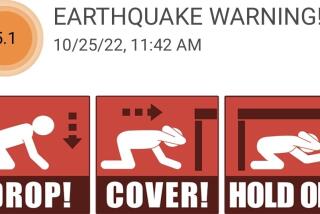Formula Developed by U.S.-Soviet Team to Help Predict Quakes
- Share via
Soviet and U.S. scientists say they have moved somewhat closer to predicting strong earthquakes by developing a mathematical formula that shows how certain seismic patterns precede some big jolts.
“This is a step toward improving the prediction of large earthquakes in time and space,” said geophysicist Leon Knopoff, a UCLA geophysics professor and co-author of the study being published today in the British journal Nature.
The new method has not yet been used to predict earthquakes and will not allow scientists to predict that a quake will occur at a precise time and place.
But it will allow them to make more general predictions saying that a strong earthquake is likely within three years somewhere in a broad region, such as Southern California or the northern Appalachians, Knopoff said Wednesday.
Knopoff conducted the study with Vladimir Keilis-Borok and I. M. Rotwain, both of the Soviet Academy of Sciences’ Institute of the Physics of the Earth, and Caltech geophysicist-geologist Clarence Allen, the former chairman of the National Earthquake Prediction Evaluation Council.
If the new method is proven valid, it will help government officials and residents because “even a vague description of the area that could be at risk and a refinement in the time scale is valuable,” said Mike Guerin, spokesman for California’s Office of Emergency Services.
But such a vague prediction would make it “very difficult to do anything more than is already being done in California in terms of preparedness,” countered Randall Updike, executive secretary of the quake prediction council and deputy chief of the Geological Survey’s office of earthquakes, volcanoes and engineering.
The council reviewed the new method during a meeting in June. Members decided that while it was a step forward and should be studied further, it would be premature to use it immediately to predict three-year periods in which large quakes were likely, said James Davis, a council member and chairman of the California Earthquake Prediction Evaluation Council.
The Soviet-UCLA-Caltech team devised a complicated mathematical formula to identify “times of increased probability”--roughly three-year periods in which certain patterns of seismic activity are likely to culminate in a strong earthquake.
They developed the formula by studying seismic patterns that preceded 14 earthquakes of 6.4 magnitude or more that rocked California and Nevada between 1938 and 1984. The scientists then tested the formula by applying it to 20 quakes in five other regions of the world since 1963.
More to Read
Sign up for Essential California
The most important California stories and recommendations in your inbox every morning.
You may occasionally receive promotional content from the Los Angeles Times.










